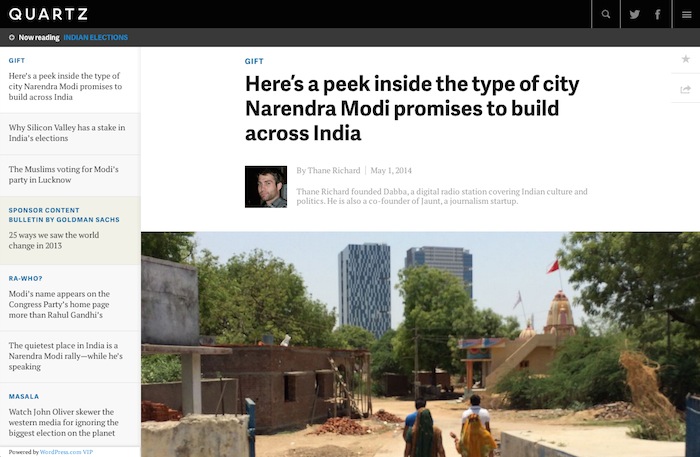The newsonomics of Quartz, 19 months in

The mobile-first, obsessions-driven business news site from Atlantic Media has a lot of new competition — but it also has some opportunities for growth....MUCH MORE
Quartz, at the tender age of 19 months, can hardly be considered a father to Vox, FiveThirtyEight, and The Upshot. Clearly, though, it’s a major influence. It marked and followed an explanatory way forward way back in September 2012 (“The newsonomics of Quartz’ business launch”), and its model tells us a lot about this widening field.
Fast innovator Atlantic Media wrote the playbook for Quartz. That playbook almost seemed too fashionable:
✓ Designed for mobile and web-nativeEven the name Quartz seemed a bit avant-garde, its qz.com url a little unorthodox. We knew what a Fortune, a BusinessWeek, a Wall Street Journal, an Economist, a Financial Times meant, both directly through their names and through their long histories. Quartz seemed to be going up not only against all of those, but Bloomberg, Forbes, and Thomson Reuters as well. All those business brands seemed formidable and more greatly staffed in journalists than Quartz.
✓ A browser app only, not available as iOS or Android native apps
✓ No small-unit banner ads, with native ad “posts” the primary format
✓ Focused on visuals, with big photos and lots of sharable charts
✓ A global focus, in coverage and in audience, from the start
And yet, before its second birthday, Quartz has found a niche. Let’s look at its newsonomics and how they provide a window into the hot “explainer” movement.
In short, its influence on today’s digital news world derives from three things: Its impressive audience and advertising strategy; its own “obsessive” model of mobile-friendly, explanatory journalism; and the wider sending of Atlantic/Quartz talent off into positions of influence in the next news, and its influence on a wide range of sites that have launched since Quartz’s birth.
Let’s take the talent point.
Justin B. Smith, Atlantic Media’s then-president, was a key shaper of Quartz. Smith is now CEO of Bloomberg Media, with a huge staff, deep pockets, and lots to figure out. His fellow co-conspirator at Atlantic Media and with Quartz, Scott Havens, just joined the soon-to-be-new Time Inc. as senior vice president for digital, after five years at Atlantic. Andrew Perlmutter, an Atlantic strategist at the time of Quartz’s launch, was named executive vice president of Boston Globe Media Partners by new owner and publisher John Henry. Just last week, well-followed Quartz writer Christopher Mims (from his bio: “He believes that the most interesting things about the universe have yet to be discovered, and that technology is the primary driver of cultural change. He is often surprised and delighted by what people will say on record”) took on the WSJ personal tech column job that Farhad Manjoo had vacated in January by leaving for The New York Times. That’s a confluence of influence that speaks to the thinking and execution at Quartz and elsewhere within Atlantic Media.
So, let’s look at the numbers Quartz reports:
- About 4.7 million monthly unique visitors.
- 40 percent of readers are from outside the U.S. The top five countries, in order: U.S., U.K., Canada, Australia, and India. Given the India audience, Quartz is launching its first non-U.S.-centric site, Quartz India, in June, partnered with scroll.in.
- More than 60 percent of the audience is executive level (according to Bizo), with 90 percent of the U.K. audience at that level.
- 70 percent are male, and with an expected skew to tech, sometimes standalone tech and often tech within a variety of companies.
- 40 percent of its traffic is from mobile, with mobile heaviest on evenings and weekends, as at other news sites. Smartphone usage dominates the early morning, and out-distances tablet usage overall about 4-to-1.
- Fully 70 percent of traffic is driven by social links.
- 70,000 readers have signed up for The Daily Brief newsletter. The newsletter has been an important driver of habit and usage — and registration data....